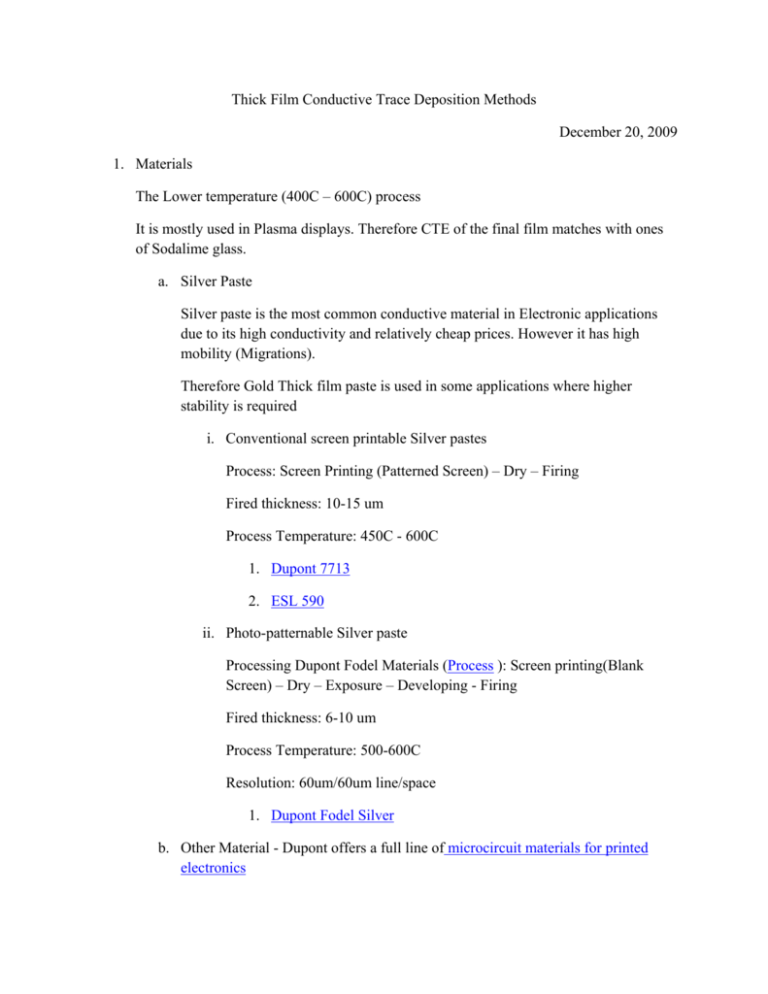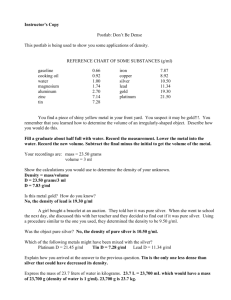
Thick Film Conductive Trace Deposition Methods
December 20, 2009
1. Materials
The Lower temperature (400C – 600C) process
It is mostly used in Plasma displays. Therefore CTE of the final film matches with ones
of Sodalime glass.
a. Silver Paste
Silver paste is the most common conductive material in Electronic applications
due to its high conductivity and relatively cheap prices. However it has high
mobility (Migrations).
Therefore Gold Thick film paste is used in some applications where higher
stability is required
i. Conventional screen printable Silver pastes
Process: Screen Printing (Patterned Screen) – Dry – Firing
Fired thickness: 10-15 um
Process Temperature: 450C - 600C
1. Dupont 7713
2. ESL 590
ii. Photo-patternable Silver paste
Processing Dupont Fodel Materials (Process ): Screen printing(Blank
Screen) – Dry – Exposure – Developing - Firing
Fired thickness: 6-10 um
Process Temperature: 500-600C
Resolution: 60um/60um line/space
1. Dupont Fodel Silver
b. Other Material - Dupont offers a full line of microcircuit materials for printed
electronics
i. Gold paste
Advantages: Very stable, High conductivity
Disadvantages: Very expensive, relatively higher firing temperature (650
– 800C)
ii. Ni Paste, Cu paste: Available but not very reliable.
2. Screen Printing
Mesh selection by the resolution of the pattern and target thickness of the paste.
250um( line/space), 15-20 um thick : #325 mesh
150um (line/space), 6 -10 um thick : #400 mesh
3. Summary
Silver thick Film material is the most common and easiest choice to replace thin film
traces for the device. Screen printing with fine pattern ( 150um/150um line/space ) is
quite common in the Display industry and it can be done with some process optimization
efforts. Photo Sensitive Silver material (Fodel) is a convenient choice with very fine
resolution and reliability. However the difference in the material cost between regular
silver and Fodel has been always the blocking stone on the road. It is about 10X
expensive.
Thanks
Seungwoo Lee
DuPont Microcircuit Materials
Printed Electronics Product Overview
This is a product overview of DuPont Microcircuit
Materials (MCM) offerings of functional inks for the
Printed Electronics Market. There are several inks available depending on the specific application, substrate,
and dispensing method. Please contact your local MCM
representative for specific product recommendations.
Biosensor Materials
Product
Material
Description
Electrode Materials
Membrane Touch Switch Materials
Product
Material
Description
5000
Silver
Silver Conductor for Low Voltage Applications
5021
Silver
Low Temperature Very Flexible Silver Conductor
5025
Silver
Silver Conductor for Higher Temperature
5028
Silver
High Conductivity Fast Drying Silver Conductor
5064
Silver
High Conductivity Silver Conductor
6492
Silver
Syringe Dispensed Silver Conductor
7102
Carbon
Carbon Conductor
BQ221
Carbon
High Activity for Blood Glucose Sensors
3571
Dielectric
Blend Member Dielectric
BQ242
Carbon
Good Activity for Blood Glucose Sensors
5018
Dielectric
Blue UV Curable Dielectric
7105
Carbon
Excellent Conductivity for All Applications
5018A
Dielectric
Colorless UV Curable Dielectric
7102
Carbon
Good Conductivity for All Applications Including
Polycarbonate
5018G
Dielectric
Green UV Curable Dielectric
5870
Ag/AgCl
80/20 Ag/AgCl for All Sensor Types
5036
Dielectric
Blend Member Dielectric Compatible with
7102 and 7082
5874
Ag/AgCl
68/32 Ag/AgCl for All Sensor Types
7082
Resistor
1K Ohm/sq Resistor Ink
5876
Ag/AgCl
32/76 Ag/AgCl for Iontophoretic/Specialty
Applications
7105
Resistor
Highly Conductive Carbon Ink
5807
Ag/AgCl
20/80 Ag/AgCl for Specialty Applications
5025
Silver
All-Purpose Conductor
5064
Silver
Excellent Conductivity (4mohm/sq/mil)
Product
Material
5028
Silver
Excellent Conductivity/May be Used on Polycarbonate
CB028
Conductor
Silver Conductor
CB100
Via Plug
Silver Via Fill
Silver/Carbon
Silver/Carbon Blend (25 mohm/sq/mil)
CB102
Via Plug
Solventless Silver Via Fill
BQ321
Platinum
Platinum Conductor for Sensors
CB200
Conductor
Copper Conductive Material
BQ331
Gold
Gold Conductor for Sensors
CB230
Conductor
Silver Coated Copper Solderable Conductive
Material
CB459
Conductor
Platable Silver Conductor
CB500
Temporary
Conductor
Silver Conductor Removable Plating Link for
Electroplating Applications
5524
Dielectric Materials
5018
Dielectric
All-Purpose UV-Curable (Blue)
5018G
Dielectric
All-Purpose UV-Curable (Green)
5018A
Dielectric
All-Purpose UV-Curable (Colorless)
5036
Dielectric
All-Purpose Thermal Cure
RFID Antenna Materials
Product
Material
Description
5028
Conductor
High Conductivity Fast Drying Silver Conductor
5029
Conductor
Thick Printing Silver Conductor
5064
Conductor
High Conductivity Silver Conductor
5069
Conductor
Water Based Flexographic Silver Conductor
Printed Materials for Printed Circuit Boards
Description
Touch Screen Materials
Product
Material
9169
Conductor
Low Temperature Silver Conductor for
Adhesion on ITO
Description
5018
Dielectric
Blue UV Curable Dielectric
7713
Conductor
500 C Fireable Silver Conductor
7723
Conductor
Lead-Free 500C Fireable Silver Conductor
LuxPrint Electroluminescent Materials
Specialty Silver Materials
®
Description
Product
Material
Description
Product
Material
4817N
Silver
Dip/Sprayable Plateable Silver Conductor
8144
Carbon
Carbon Conductor for ITO
4922N
Silver
Brush/Band Plateable Silver Conductor
9145
Silver
Silver Conductor for ITO
4929N
Silver
Screen Printable Plateable Silver Conductor
7164
Translucent
Translucent Conductor
5064
Silver
All Purpose High Conductivity Silver Conductor
8153
Dielectrics
High K Dielectric
5504N
Silver
Screen Printable Plateable Thermoset
Conductive Epoxy
8150B
Phosphor
High Brightness White Phosphor
8150L
Phosphor
Long Life White Phosphor
8152B
Phosphor
High Brightness Blue Green Phosphor
8152L
Phosphor
Long Life Blue Green Phosphor
8154L
Phosphor
Long Life Yellow Green Phosphor
8155
Vehicle
Medium
5815
Silver
Dip/Sprayable Thermoset Conductive Epoxy
6492
Silver
Syringe Dispensable Plateable Silver Conductor
DuPont MCM also offers a wide range of products for other
Printed Electronic applications, including Flexible Displays
and Printed Batteries. Please visit our website for technical
information or contact us for specific product recommendations.
For more information on DuPont Microcircuit Materials products, please contact your local representative:
Americas
DuPont Microcircuit Materials
14 T.W. Alexander Drive
Research Triangle Park, NC 27709
Tel: 800.284.3382
Europe
DuPont (UK) Limited
Coldharbour Lane
Bristol BS15 QD
England
Tel: 44.117.931.3191
Asia
DuPont Kabushiki Kaisha
Sanno Park Tower, 11-1
Nagata-cho 2-chome
Chiyoda-ku, Tokyo 100-6111
Japan
Tel: 81.35.521.8650
mcm.dupont.com
Copyright © 2009 DuPont or its affiliates. All rights reserved. The DuPont Oval, DuPont™, The miracles of science™ and LuxPrint®, are registered trademarks
or trademarks of E.I. du Pont de Nemours and Company or its affiliates.
NO PART OF THIS MATERIAL MAY BE REPRODUCED, STORED IN A RETRIEVAL SYSTEM OR TRANSMITTED IN ANY FORM OR BY ANY MEANS
ELECTRONIC, MECHANICAL, PHOTOCOPYING, RECORDING OR OTHERWISE WITHOUT THE PRIOR WRITTEN PERMISSION OF DUPONT.
Caution: Do not use in medical applications involving permanent implantation in the human body. For other medical applications, see “DuPont Medical Caution
Statement,” H-50102.
This information is based on data believed to be reliable, but DuPont makes no warranties, express or implied, as to its accuracy and assumes no liability arising
out of its use. The data listed herein falls within the normal range of product properties but should not be used to establish specification limits or used alone as
the basis of design. Because DuPont cannot anticipate or control the many different conditions under which this information and/or product may be used, it does
not guarantee the usefulness of the information or the suitability of its products in any given application. Users should conduct their own tests to determine the
appropriateness of the product for their particular purposes.
This information may be subject to revision as new knowledge and experience become available. This publication is not to be taken as a license to operate under,
or recommendation to infringe, any patent.
K-23354-2 11/09
Electro-Science Laboratories, Inc.
416 East Church Road • King of Prussia, PA 19406-2625, U.S.A
610-272-8000 • Fax: 610-272-6759 • www.ElectroScience.com • Sales@ElectroScience.com
590
590-G
CERMET SILVER CONDUCTOR
ESL 590 and ESL 590-G conductive pastes offer versatility and superior performance
in many applications. These low cost compositions may be selected for applications
requiring shielding, solder seal metallization for axial components, and conductive
wiring. With their versatility, 590 and 590-G can also be used in AC and DC plasma
displays, and as terminations for monolithic capacitors and capacitor electrodes. Both
590 and 590-G exhibit excellent adhesion, high conductivity and electroplatability.
They also feature very low firing temperature characteristics.
Suitable substrates include silicon wafers, various ceramics, porcelain enameled steel,
soda-lime and other glass substrates. These conductive coatings are compatible with
various glossy and matte finish dielectrics.
PASTE DATA
RHEOLOGY:
Thixotropic, screen printable paste
VISCOSITY:
(Brookfield RVT, ABZ Spindle, 10 rpm, 25.5°C±0.5°C)
590
250±25 Pa•s
590-G
225±25 Pa•s
BONDING MECHANISM:
Fritted
SHELF LIFE: (25°C)
6 months
PROCESSING
325/25 µm
SCREEN MESH/EMULSION:
LEVELING TIME: (25°C)
5-10 minutes
DRYING AT 125°C:
10-15 minutes
590/G 9808-F
ESL Affiliates
Japan: ESL-Nippon Company, Ltd. • Sukegawa Bldg. • 6 floor • 3-4 Yanagibashi 1-chome • Taito-ku • Tokyo 111, Japan • Tel: (011-81)-3-3864-8521 • Fax: (011-81)-3-3864-9270
NipponSales@ESLNippon.com
th
China: Shanghai Agmet Electro-Science Laboratory Ltd. • Second Floor Bldg. 12A1 • #223 North Fe Te Road • Waigaoqiao Free Trade Zone • Shanghai, China
Tel: (011-86)-21-5866-0497 • Fax: (011-86)-21-5866-0497 • ShanghaiSales@ShanghaiESL.com
Europe: Agmet, Ltd. • 8 Commercial Road • Reading, Berkshire, England RG2 0QZ • Tel: (011-44)-118-987-3139 • Fax: (011-44)-118-986-7331 • Sales@ESLEurope.co.uk
See Caution and Disclaimer on other side.
FIRING RANGE:
OPTIMUM PEAK TEMPERATURE/TIME AT PEAK:
590
500°C-700°C
590-G
450°C-580°C
590
590-G
RATE OF ASCENT/DESCENT:
580°C/10-15 min.
450°C/35 min.
60°C-100°C/minute
SUBSTRATE OF CALIBRATION:
glass
THINNER:
ESL 401 or 404
TYPICAL PROPERTIES
FIRED THICKNESS:
RESISTIVITY:
590
12.5±2.5 µm
590-G
12.0±3.0 µm
3-5 mΩ/sq.
PRINTING RESOLUTION:
(Line/Space)
SOLDER WETTABILITY:
(RMA flux, 5 sec. dip)
125 µm x 125 µm
62 Sn/36 Pb/2 Ag, 220°C±5°C
good-excellent
ADHESION:
(90° pull, 2.5 mm x 2.5 mm pads, 62 Sn/36 Pb/2 Ag)
Initial pull strength:
10±0.5 N
590/G 9808-F
CAUTION: Proper industrial safety precautions should be exercised in using these products. Use with adequate ventilation. Avoid prolonged contact with skin or inhalation of any vapors emitted during use or heating
of these compositions. The use of safety eye goggles, gloves or hand protection creams is recommended. Wash hands or skin thoroughly with soap and water after using these products. Do not eat or smoke in
areas where these materials are used. Refer to appropriate MSDS sheet.
DISCLAIMER: The product information and recommendations contained herein are based on data obtained by tests we believe to be accurate, but the accuracy and completeness thereof is not guaranteed. No
warranty is expressed or implied regarding the accuracy of these data, the results obtained from the use hereof, or that any such use will not infringe any patent. Electro-Science assumes no liability for any injury, loss,
or damage, direct or consequential arising out of its use by others. This information is furnished upon the condition that the person receiving it shall make their own tests to determine the suitability thereof for their
particular use, before using it. User assumes all risk and liability whatsoever in connection with their intended use. Electro-Science’s only obligation shall be to replace such quantity of the product proved defective.
Processing Fodel® materials:
In addition to the typical thick film production equipment, processing Fodel®
compositions properly requires the use of two additional pieces of equipment, a
UV exposure unit (Hg or Hg/Xe lamp), and an aqueous conveyorized spray
developer (to spray ~1% Na2CO3 solution). These equipment are common in the
printed wiring board industry. Fodel® compositions are sensitive to UV light
frequencies between 360 to 450 nm. Since Fodel® compositions are UV light
sensitive, they must be handled and processed under yellow safe lighting
conditions. See “Fodel Safe Lighting” pages.
Using standard stainless steel mesh printing screens, follow the data sheet
recommendations and print the composition. Dry at 80ºC. With artwork phototool
pattern in place, expose the printed sample to UV light at the specified energy
level. Then, “develop” the part by sending it through the spray developer & rinse.
(Most spray developers include a DI water rinse module and air knife as part of
the equipment.) See Fodel® Process Illustration below. Fodel® compositions are
negative acting, meaning that areas exposed to UV light are polymerized or
hardened, while unexposed areas remain soft or soluble in the developer solution.
The dried developed part may now be inspected and fired using standard thick
film furnace profiles.
PASTE
APPLICATION
SCREEN PRINT/
DRY (80°C)
COATING
SUBSTRATE
LENS
COLLIMATED U/V LIGHT
PHOTOMASK
EXPOSURE
CONVERYORIZED DEVELOPER SYSTEM
DEVELOPMENT
(I% NA2CO3)
VIAS
FIRING
Fodel® Process Illustration
DuPont™ Fodel® 8G Thick-Film Paste : DuPont Displays : PDP
1 of 2
http://www2.dupont.com/Displays/en_US/products_services/pdp/fodel/fo...
Select Industry
DuPont Home « Electronics « Displays « Products & Services « Plasma Display Panels « Fodel® 8G
Displays Home
Products & Services
Liquid Crystal Displays
Organic Light Emitting
Diodes (OLEDs)
Displays
DuPont™ Fodel® 8G
Thick-Film Paste
DuPont™ Fodel® photoimageable thick-film paste is well established
Materials for Displays
Process Innovation
(PDP) front bus electrodes to provide high resolution and improved
Films for Flexible Displays
and Electronics
image quality for large format, full high definition televisions. The
newest paste technology, Fodel® eighth generation (8G) system,
Knowledge Center
provides improved printability and wider process latitude. The
News & Events
Printer Friendly Version
DuPont Products & Services
DuPont Brands &
Trademarks
Contact Information
Contact Us for Additional
Information on DuPont™
Fodel® 8G Thick-Film Paste
ruthenium pyrochlore-based black pigments have been replaced with
News and Events
a novel and proprietary black pigment system based entirely on
Display Daily Feature Article
on Impact of DuPont® Fodel®
8G Technology [.pdf]
lower cost metals, so that PDP manufacturers can compete more
cost effectively.
CONTACT US
Plasma Display Panel Fact
Sheet [.pdf]
Microcircuit Materials
as a leading technology for the metallization of plasma display panel
Science of Displays
Product Information
Related Web Sites
Plasma Display Panels
Fodel® 8G
Helpful Links
Features and Benefits
Improved overall system performance – better resistivity, blackness,
processing margin, latitude and cycle time
Lower material costs to allow PDP manufacturers to compete more
effectively with LCD technology
Easy to use
Wider processing latitude (better printability)
Made without lead or ruthenium metals
Reduced thickness
Excellent picture quality, enabling full HD resolution
Matsushita Electric Industrial
Co. Adopts New DuPont™
Fodel® 8G Conductor System
from DuPont Microcircuit
Materials
Easy-to-Use Fodel® Process Enables Full HD Resolution
12/21/2009 12:08 PM








